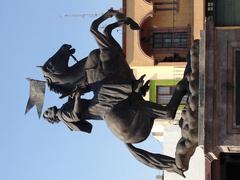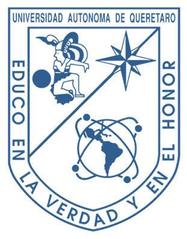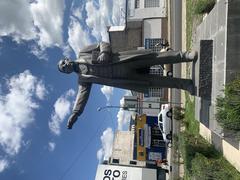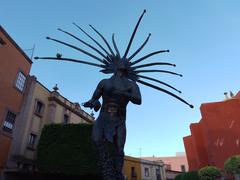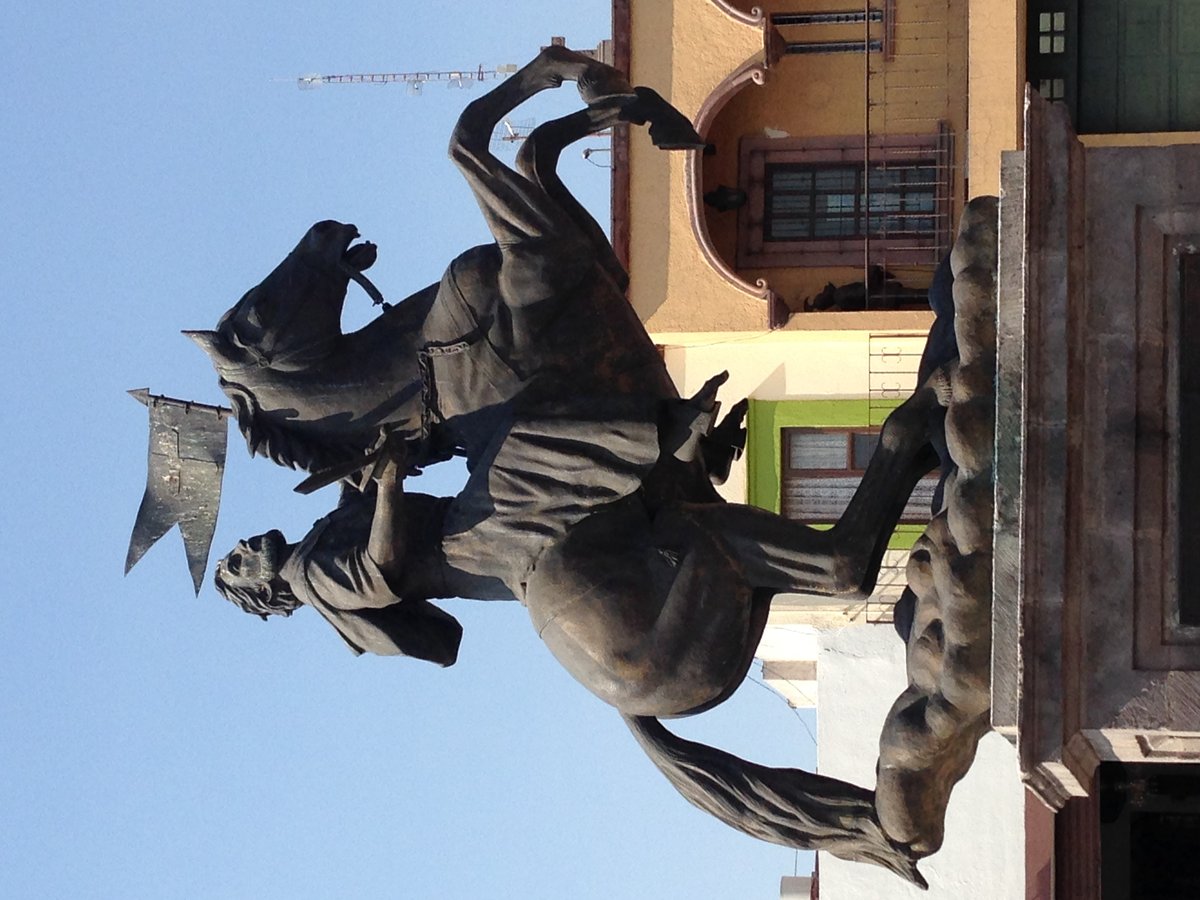
Visiting the Monument to the Apostle James the Greater in Santiago de Querétaro, Mexico: Complete Guide
Date: 14/06/2025
Introduction
Nestled in the UNESCO-designated historic center of Santiago de Querétaro, the Monument to the Apostle James the Greater (Monumento al Apóstol Santiago el Mayor) stands as a profound emblem of the city’s layered history and enduring religious devotion. Honoring the city’s patron saint—Santiago, or St. James the Greater—the monument is a touchstone for cultural identity, community pride, and centuries-old traditions that have shaped Querétaro since its founding in 1531.
This comprehensive guide provides essential insights for travelers, covering the monument’s historical and artistic significance, practical visitor information (including hours, ticketing, and accessibility), cultural context, and nearby attractions. Whether you are a pilgrim, history enthusiast, or curious explorer, this landmark offers a unique window into the soul of Santiago de Querétaro (Travel With The Greens; UNESCO World Heritage: Querétaro; Epicurean Expats).
Historical and Cultural Significance
Foundations of Santiago de Querétaro
Founded on July 25, 1531—the feast day of St. James—the city of Querétaro emerged from a pivotal encounter between indigenous Otomí and Chichimeca peoples and Spanish conquistadors. According to legend, a miraculous vision of St. James, mounted on a white horse and bearing a cross, appeared during a crucial battle on Cerro de Sangremal. This apparition led to the indigenous surrender and the city’s peaceful founding—a narrative enshrined in local iconography and commemorated by this monument (Travel With The Greens).
The city’s urban landscape reflects its multi-ethnic roots, preserving a dual grid of Spanish colonial and indigenous neighborhoods—a heritage recognized by UNESCO (UNESCO World Heritage: Querétaro).
The Cult of St. James in New Spain
St. James the Greater, venerated as the patron of both Spain and Querétaro, is depicted in two main forms: the humble pilgrim and “Santiago Matamoros” (the Moor-slayer)—the latter symbolizing Christian protection and conquest. In colonial Mexico, his imagery reinforced Spanish authority and became a rallying point for faith, especially during annual festivities on July 25th (Wikipedia).
The Monument: Description, Symbolism, and Setting
Location and Design
The Monument to the Apostle James the Greater is strategically situated in Querétaro’s historic center, often near the Templo y Convento de la Santa Cruz on Cerro de Sangremal. This elevated position offers panoramic views of the city’s colonial skyline and aqueduct (Nicki Posts Travel Stuff).
Artistic Features
Typically crafted from bronze or stone, the monument depicts St. James astride a horse, sword in hand, and adorned with the scallop shell—symbol of the Camino de Santiago pilgrimage. The base may include inscriptions and reliefs narrating the city’s founding legend and scenes from the saint’s life. Baroque influences shine through in its dynamic poses and intricate details (Backpacking Brunette).
Symbolism
The monument embodies both Christian faith and Querétaro’s distinctive fusion of indigenous and Spanish colonial traditions. It serves as a gathering place for processions, prayers, and reflection—especially during the feast day of St. James, when the plaza becomes the heart of citywide celebrations (Mexico Travel Secrets).
Visitor Information
Visiting Hours and Tickets
- Hours: Open daily, typically from 8:00 AM to 8:00 PM. Hours may extend during special events or festivals.
- Admission: Free of charge for monument and plaza access; adjacent sites like the Templo y Convento de la Santa Cruz may have separate hours or fees for guided tours.
- Best Times: Early morning or late afternoon for pleasant weather, optimal lighting, and fewer crowds. July 25th is especially vibrant with festivities (The Vanabond Tales).
Accessibility
- Physical Access: The monument is on a hill but is reachable via paved and gently sloped walkways. The area is wheelchair accessible, though some cobblestone streets nearby may be uneven.
- Visitor Amenities: Nearby restrooms, cafés, and shops enhance the experience. Interpretive signage provides historical context.
Guided Tours
Local operators offer guided walking tours (Spanish and English) that include the monument and other colonial landmarks. Booking in advance is recommended during peak travel seasons (Epicurean Expats). Digital tools like the Audiala app are also available for self-guided exploration.
Getting There
Querétaro’s historic center is pedestrian-friendly and easily accessible by foot from most downtown hotels. Taxis and ride-sharing services are widely available; parking lots are located nearby for those arriving by car.
Nearby Attractions
Enhance your visit by exploring these nearby sites:
- Templo y Convento de la Santa Cruz: Site of the legendary apparition and home to the miraculous thorn tree (Mexico Travel Secrets).
- Aqueduct of Querétaro: An iconic 18th-century engineering marvel visible from the monument (Nicki Posts Travel Stuff).
- Plaza de Armas & Jardín Zenea: Bustling plazas with street performers, markets, and colonial architecture.
- Museo Regional de Querétaro: Exhibits on pre-Hispanic and colonial history.
- Local Cafés & Artisan Shops: Sample regional cuisine and crafts (The Vanabond Tales).
Events and Living Traditions
Feast Day of St. James (July 25th):
The city comes alive with processions, music, traditional dances, and communal meals. The monument is central to these celebrations, drawing locals and tourists alike (Backpacking Brunette).
Frequently Asked Questions (FAQ)
Q: What are the visiting hours?
A: Typically 8:00 AM–8:00 PM daily; extended hours during festivals.
Q: Is there an admission fee?
A: No, monument and plaza access is free. Some guided tours or adjacent sites may require payment.
Q: Are guided tours available?
A: Yes, in Spanish and English; book in advance for peak dates.
Q: Is the monument wheelchair accessible?
A: Yes, with paved paths and ramps.
Q: When is the best time to visit?
A: Early mornings, late afternoons, or July 25th for festivities.
Q: What else is nearby?
A: Historic churches, the aqueduct, plazas, museums, and cafés are all within walking distance.
Essential Visitor Information Summary
| Aspect | Details |
|---|---|
| Foundation Date | July 25, 1531 (Feast of St. James) |
| Location | Cerro de Sangremal, Historic Center, Querétaro |
| Admission | Free (fees may apply for certain tours/events) |
| Accessibility | Wheelchair accessible |
| Nearby Sites | Templo y Convento de la Santa Cruz, Aqueduct, plazas, museums |
| Major Festival | July 25th, Feast of St. James |
| Guided Tours | Available in Spanish and English |
| Best Time to Visit | Early morning, late afternoon, July 25th |
Responsible Tourism and Additional Tips
- Dress modestly, especially during religious events.
- Support local businesses by shopping and dining in the historic center.
- Be respectful of worshippers and ongoing ceremonies.
- Take advantage of digital guides like Audiala for self-guided tours.
- Plan ahead if visiting during major festivals, as crowds and traffic increase.
Conclusion and Final Recommendations
The Monument to the Apostle James the Greater is more than an artistic landmark—it’s a living testament to Querétaro’s unique blend of legend, faith, and cultural resilience. A visit here offers not only stunning views and photo opportunities but also a deeper appreciation for the city’s pivotal role in Mexican history.
Accessible, centrally located, and surrounded by centuries of heritage, the monument is a must-see for anyone seeking to understand the spirit of Santiago de Querétaro.
Plan your visit today! Download the Audiala app for up-to-date hours, tour options, and interactive maps. For more on Querétaro’s historical sites and travel insights, consult official tourism resources and the recommended links below.
Sources and Further Information
- Travel With The Greens
- Wikipedia
- Epicurean Expats
- Mexico Travel Secrets
- UNESCO World Heritage: Querétaro
- Backpacking Brunette
- The Vanabond Tales
- Nicki Posts Travel Stuff
- Caminosantiago Compostela
- Mondo Cattolico
- Viajecaminodesantiago
